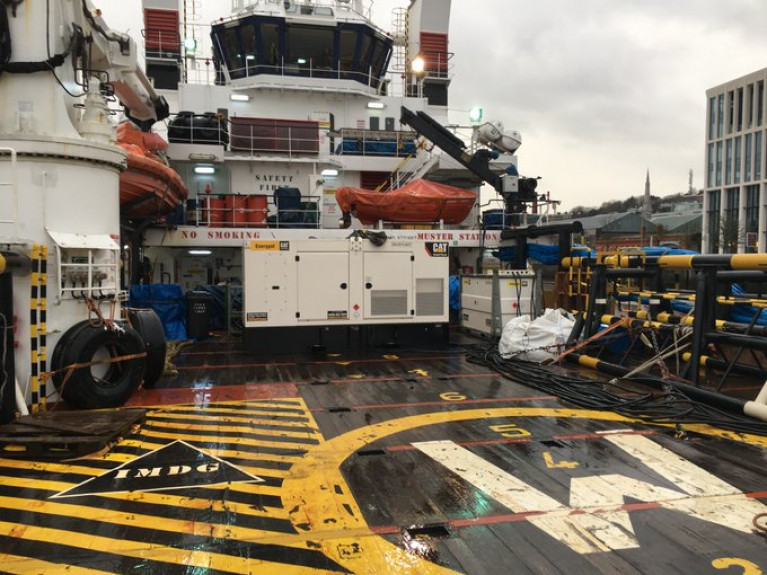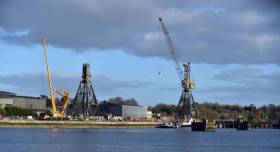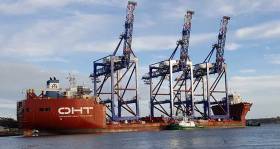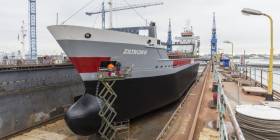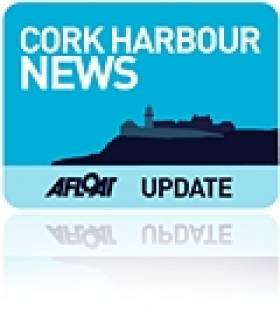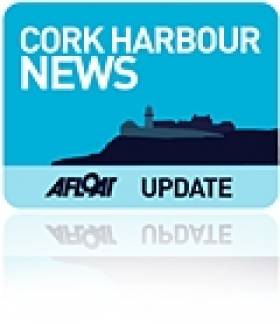Displaying items by tag: Cork Dockyard
At the Cork Dockyard facility at Rushbrooke, Cork Harbour is where redevelopment plans to service planned offshore wind projects have taken a step forward.
The plan to support offshore windfarm projects is proposed by the Doyle Shipping Group (DSG) which is to redevelop the site as a port infrastructure hub for use by developers of offshore renewable energy (ORE) projects. DSG, the largest port service solutions provider in Ireland with offices in seven ports, has labelled the project, the Cork Dockyard Rejuvenation Project (CDR)
As the Irish Examiner reports, DSG has in recent days issued its tender documents to seek a public relations firm to deliver a strategy for the public consultation process at the site of the former Cork Verolme Dockyard (V.C.D.) shipyard. The current marine engineering facility of Cork Dockyard, carries out ship-repair, survey / dry-dockings including use by the Naval Service.
As the project is large-scale, the ORE falls into the category of a Strategic Infrastructure Development (SID) and as such the application for planning permission lies with An Bord Pleanála.
Approximately 15 hectares is the dockyard site which comprises a graving dry-dock for ship-repair and the adjoining redundant shipyard which was the largest in the Republic. The origins of the shipyard can be traced to its establishment in 1853 and for many decades was considered one of the most significant elements of the harbour's industrial infrastructure.
During the shipyard’s peak, more than 1,100 were employed at the Rushbrooke site as Afloat highlights is where major vessels including those for Irish Shipping Ltd, B+I Line, Sealink/British Rail and the Naval Service including flagship L.E. Eithne were built and launched.
The V.C.D. shipyard however closed in 1984 with the last vessel built, L.E.Eithne for the Navy, noting this ship would also become historically significant, as the last ever ship to be built in the Republic.
More than a decade after the closure of Ireland’s only shipbuilding yard, the site was acquired by DSG in 1995.
Further reading here on the plans for the ORE facility, which will not interfer with the dockyard's ship-repair infrastructure.
Cork Dockyard's completion to convert a Mainport Group offshore supply vessel acquired in Africa, as Afloat reported in January, is expected to see the ship depart drydock shortly, prior to a new role in the offshore renewables sector, writes Jehan Ashmore.
The Mainport Geo (formerly Oya), of 1,240 gross tonnage and which cost around €15m to build in 2015, had been operating for previous owners, with the 50m vessel based in the Ivory Coast.
The west African state was challenging to reach for Mainport given Covid-19 restrictions, but was to enable an inspection of the vessel last summer before making a delivery voyage to Cork Harbour.
As previously covered, the conversion took place at Doyle Shipping Group's (DSG) Cork Dockyard, so to transform Mainport Geo into a 'top-class survey vessel in the new year' according to the Group.
For more than 40 years, the group's main role has been to serve the Kinsale Gas Field, where operations are to end this year, that will lead platforms to be decommissioned.
The company also operates a subsidairy, Celtic Tugs on the Shannon and seismic ships for the global hydro-carbon industry, but is diversifying into the offshore renewables sector as 'Seascapes' last week also highlighted.
Mainport see the great potential of companies in developing wind-farms projects off the south and west Irish coasts. In addition international clients seeking such related survey/scientific ships have already led to interested players about the Mainport Geo coming from the North Sea but also to survey the seabed off Angola, also in west Africa.
To meet the requirements of such specialist ships, the conversion included a new mezzarine deck. This is to feature an Remotely Operated Vehicle (ROV) and a launch and recovery system (LARS) located on this new deck to deploy and retrieve the ROV.
To conduct survey work, a new port side crane was installed to handle an underwater survey baseline (USBL) pole. This difficult operation entailed marine engineering skills at Cork Dockyard (see Verolme shipbuilding era) to incorporate the techology by inserting 3m within the hull and to allow an outreach of a 1.5m survey pole positioned below the keel.
Also as part of the survey systems, involves the use of gliding multi-beams surveys, by using a blue pole also placed under base of the ship. These techologies map the sea bed structure and identify where suitable to install the base of wind-farm turbine towers.
As Afloat also previously mentioned, Mainport Geo is fitted with Dynamic Positioning (DP2-class) technology to enable the ship to maintain an exact stationary location while in deep seas, where conditions would not be possible with an anchor coupled with currents and waves.
The DP system is linked up with satellittes, where computers constantly monitor and adjust the ship's thrusters to pin-point accuracy where precision of seabed survey work can be maintained.
Unlike the rest of the Mainport fleet which have the company colours of a blue hull and white superstructure, Mainport Geo sports a red hull with the white forward deckhouse for 35 crew.
The reason for the red, cited Mainport was that the prior owner had intended to carry out the 5-year special ship survey and this involved purchase of red paint.
As such these paint drums remained on board and given the cost benefit, they were readily put to good use with the Munster based vessel so far, carrying aptly the same colours of the 'Rebel' county.
When Mainport Geo is floated off the stocks in Cork Dockyard, the ship will carry out trials at sea before the first constractor is secured leading to the ship's debut commercial deployment.
Cork Based Mainport Group Newly Acquired Ship Dry Docks for New Role
Cork based Irish Mainport Holdings acquisition of a five year old utility and offshore supply vessel from Africa that arrived in late 2020 to the southern port, has since relocated downriver to lower Cork Harbour for drydocking, writes Jehan Ashmore.
The Mainport Group which provides marine services to ship-owners, oil and seismic survey companies, as Afloat previously reported, announced it had entered into the Offshore Wind Sector with the investment of the 2015 built Oya. The vessel's dimensions are the following: length (50m), beam (13.5m) and a draught of (4.3).
Afloat has identified Oya's keel was laid down in 2014 and the newbuild was completed the following year at the Turkish shipyard of Aksoy Gelibolu. The vessel has been described as a Utility and Supply vessel (with a bollard pull of 35 mt).The ship has a DP 2 system, quieter and economic diesel-electric engines and with FIFI 1 and SPS notation for 35 (crew and other personnel) all accommodated in 19 cabins.
The Marshall Islands flagged Oya had previously been working in waters off the Ivory Coast in west Africa before making a delivery voyage to Ireland. This involved an en-route call to Las Palmas in the Canary Islands with an arrival to its new owners homeport in mid-December.
Cork Dockyard located in Rusbrooke close to Cobh, is to carry out the 1,240 gross tonnage ship's 5-year special drydock survey. Among the vessel's extensive features is a deck crane fitted on the aft work deck. In addition for the new ship's role, there are plans to convert the ship which Mainport last month said will see a 'top-class survey vessel in the new year'.
During December's berthing in Cork City Quays, Oya was in the company of some of the Mainport fleet, the seismic support ship Irish Cedar and tug Celtic Isle. These vessels remain berthed at North Customs Quay from where Afloat tracked the Oya which yesterday morning made a short passage along the River Lee through Lough Mahon and then to enter Cork Dockyard.
Following the closure of the largest drydock in the Irish State by the Dublin Port Company to facilitate the Alexandra Basin Redevelopment (ABR) Project, this leaves only Cork with the 'ship' dockyard facility. This is operated by another of the city's marine companies, the Doyle Shipping Group which has operations throughout the island.
At the same time of last year's Mainport expansion into the offshore wind industry, the group also brought a share in Wicklow based offshore services company, Alpha Marine. Among its activities is the servicing of the nearby Arklow Bank Wind Farm.
Iconic Cranes at Verolme Cork Harbour Come Down
#CorkHarbour - A pair of historic cranes which have loomed large over Cork Harbour for six decades are being dismantled.
The cranes the Evening Echo writes, were used for building ships at the Verolme Dockyard at Rushbrooke, which closed in 1984 (see: Afloat's coverage on 160 years of Cork Shipbuilding).
They have been central to the skyline of Rushbrooke, west of Cobh and across the harbour from Monkstown for over 60 years.
Dutch company Verolme once employed more than 1,100 workers at the site and many ships were launched there including Irish Naval Vessel LÉ Eithne.
The site is now run by the Doyle Shipping Group which has confirmed that the iconic twin cranes will be dismantled fully within the next week due to concerns that they are dangerous.
To read more click the report here.
Afloat adds the site is ironically where much larger gantry cranes have recently been assembled by manufacturer Liebherr for export.
Last week the heavylift vessel HHL Lagos loaded with the cranes on board called to a UK port where the ship-to-shore cranes will be used in a container terminal.
Irish Flagged Channel Islands Serving Cargoship Dry Docks in Cork
#corkharbour – An Irish owned cargoship that operates a UK-Channel Islands service is currently drydocking in Cork Harbour, writes Jehan Ashmore.
Huelin Dispatch is undergoing her first 5-year special survey in Cork Dockyard, the ship repair and general engineering facility that is part of the Doyle Shipping Group (DSG). The dry-dock at just over 165m in Rushbrooke (close to Cobh) is the largest in the State following the closure of Dublin Graving Docks earlier this year.
As previously reported on Afloat, the dry-dock facility in Dublin at 220m long had been a customer of Huelin Dispatch two years ago this month.
On this call to Cork Harbour the 89m tween-decker owned by Dundalk Shipping had sailed from Southampton. The UK south coast port along with Portsmouth are from where the 2,597 tonnes Huelin Dispatch operates services while on charter to Channel Island Lines. The dry-cargoship provides a vital link to St. Peter Port, Guernsey and St. Hellier, Jersey.
The ship was completed for her Irish owners by the Dutch Damen Group in 2012. The newbuild entered the Channel Islands freight run that same year, transports containers as well as hazardous shipments.
Cranes Loaded On Board Albatross Ship & Ready for Departure From Cork Harbour This Week (VIDEO)
All three massive cranes are now loaded onboard the Offshore Heavy Transport (OHT) ship Albatross at Cork Dockyard. Departure from Cork Harbour on a 3,800–nautical mile voyage to Puerto Rico later is scheduled for later this week.
As Afloat.ie reported previously, the cranes have been asembled from kit form having first been shipped by sea from Fenit in County Kerry to the Doyle Shipping Group Terminal at Rushbrooke in Cork Harbour.
Heightened Activity in Cork Dockyard Evokes Memories of Floating Dry-Dock
#FloatingDock - Dublin based Corrib Shipping Group’s management of a newly acquired cargoship that went into a floating dry-dock in the Netherlands last month brings memories of a similar former structure in Cork Dockyard, writes Jehan Ashmore.
The cargoship Ziltborg is the fifth in the fleet of the Irish group but is owned by Wagenborg. They are based in Delfzij where in the previous report a photo features only a close up of the ship's bow while in the Dutch floating dry-dock.
Another connection with Ireland was Dutch shipping magnet Cornelius Verolme who in 1957 was invited by the fledging State owned Irish Shipping Ltd (ISL) that set up a repair dockyard at the Rushbrooke dockyard (origins dating from 1853) to purchase and assist in the development of Irish shipbuilding industry. This led to the establishment of the Verolme Cork Dockyard.
In 1984 however V.C.D. closed and also that same year saw the collapse of ISL. Since then there have been interim owners of the dockyard and in 1995 Cork Dockyard was in the hands of Burke Shipping. The Cork family owned business still controls the dockyard and in late 2015 the shipping and logistics agency was rebranded as Doyle Shipping Group (DSG).
As reported on Afloat, Cork Dockyard is where currently large scale marine engineering activity is underway as three giant Liebherr cranes towering 85m high having been erected on site are bound for San Juan, Puerto Rico. The ship-to-shore container cranes had been manufactured at Liebherr's plant near Killarney and from there taken to the port of Fenit, Co. Kerry and shipped by sea to Cork Dockyard for assembly. Such activity evokes memories of the yard’s former floating dry-dock, again a unconventional structure that was unique in Irish waters.
The floating dry-dock was higher than the dockyard's quay and was berthed east of where the heavy-lift ship Albatross is to be loaded with the cranes. This will involve rails at the quayside to transfer the ship-to-shore container cranes before shifting berths to Ringaskiddy and eventually departure from Cork Harbour this week.
Likewise of the much higher cranes to be exported by the ship across the Atlantic to the Carribean, the floating dry-dock was too equipped with cranes. They were perched atop at the entrance of the structure.
Cork Dockyard continues to repair and overhaul ships using a conventional land-based graving dry-dock. The facility is now unique as the only drydock left in the State following the recent closure in Dublin last month. By coincidence, the graving dry-dock was opened in 1957, the same year of Verolme's notable entry into Irish maritime industry that saw 33 ships built under his stewardship as they slipped down into the River Lee. The yard at its peak employed more than 1,500, however the last vessel built in this State at V.C.D was Naval Service flagship, L.E. Eithne in 1984.
It was more than a decade ago that a visit was made to Cork Dockyard especially to observe the Siren on board the floating dry-dock which remained under new owners. Siren, a former Trinity House Lighthouse tender had sailed previously onto the silver screen in Neil Jordan’s ‘Micheal Collins’. In the film she featured as an Irish Sea mail-boat taking senior Irish delegation officials to the pivotal ‘Treaty’ negotiation talks of 1921 held in London with the British Government.
Priot to the film-making, Siren had been based during the early to mid-1990’s in both Dun Laoghaire Harbour, along the East-Pier followed by those in Dublin Port at Sir John Rogersons Quay. Siren had until then served as a survey ship in Irish waters and among ports spent some time based in Waterford City.
The presence of the aforementioned heavy-lift ship, Albatross in an Irish port is rare. The former bulk-carrier, Tordis Knutsen which was converted to carry such large loads has at Rushbrooke been accompanied within the port by another newly acquired vessel but directly Irish owned tug DSG Titan. The green-hulled tug that at first glance strongly resembles to a pair of Dublin Port tugs, is seen in the related report photograph alongside the Albatross.
The tug’s prefix, DSG as previously referred is that of Doyle Shipping Group. They chartered in the Albatross on behalf of Liebherr to transport the ship-to shore container cranes across the Atlantic Ocean.
#ResearchNavy - A Russian research vessel built during the Soviet era along with the Naval Service's newest patrol vessel LÉ Samuel Beckett (P61) are at Cork Dockyard, writes Jehan Ashmore.
Geolog Dmitriy Nalivkin of 1,935 tonnes was built in Turku, Finland during 1985. She originally had the Soviet symbolism of the 'hammer & sickle' and star on the funnel.
Three decades later and her current owners are understood to be the Marine Arctic Geological Expedition Murmansk (MAGE).
The 71m vessel is berthed alongside the quay at the facility in Rushbrooke so to have an exchange of crew personnel.
Among the other vessels at the shiprepair facility is the general cargoship Arklow Rambler also taking a riverside berth.
As previously alluded the LÉ Samuel Beckett, the 2,256 tonnes OPV is undergoing her first scheduled annual maintenance with work carried out in the dry-dock.
The OPV90 or 'Beckett' class vessel was built last year from the UK yard of Babcock Marine & Technology in Appledore north Devon.
She was commissioned in May and entered service also that month.
Ports & Shipping Review: Stena HSS off Service, Award for Seatruck, UNCTAD Sign with Irish Ports, Cork Dockyard Beats Off Stiff Competition and More
#Ports&ShippingReview: Over the last fortnight, Jehan Ashmore has reported on the shipping scene, where Stena Line close HSS operated Dun Laoghaire-Holyhead summer sailings leaving the Irish port with a revived excursion service to Howth.
For the second year running, Seatruck Ferries voted Irish Sea Shipping Line of 2014 at the Export & Freight Transport & Logistics Awards.
French container shipping giant CMA CGM signs three major trade agreements.
United Nations Conference on Trade and Development (UNCTAD) sign a Memorandum of Understanding (MoU) with the Irish ports of Dublin and Cork.
The European Sea Ports Organisation (ESPO) enhance cooperation between organisations and cruise and ferry ports.
One of the UK's largest port owners, Peel Ports Group has Irish Exporters Association (IEA) membership.
Cork Dockyard win Irish Lights contract in face off stiff competition from UK and French yards.
A sideways launch of Arklow Beacon, brings to four out of six of Arklow Shipping's newbuild series of 'green' hull designed cargoships.
#CorkDockyard – Following a previous snap-shot of Cork Dockyard, which focused on L.E. Eithne, the quays of the ship-repairs and maintenance facility is also where a coastal tanker and a seismic support vessel are berthed, writes Jehan Ashmore.
The 4,972dwt products tanker Forth Fisher belongs to Cumbrian based James Fisher Everard. She along with sister Galway Fisher which was also in Cork Harbour having anchored off Cobh yesterday beyond the Spit Bank lighthouse.
The pair are frequent callers along with other fleetmates to the Whitegate Oil Refinery, transporting cargoes to the ports along the west coast including Galway Harbour.
Further downriver at Cork Dockyard, the seismic support vessel, Mainport Elm, which is a type of vessel used to conduct surveys for the energy and exploration industry.
The Marshall Islands flagged vessel is part of a fleet of seismic vessels including tugs operated by Cork based Mainport Group, which also has the contract to serve the Kinsale Gas Field carried out by the multi-role support vessel Pearl.
In 2011, Mainport signed for their first purpose built seismic support vessel from the Piasau Shipyard in Miri Malaysia which completed Mainport Cedar a year later. In 2013 she was delivered straight into a charter service.
Seismic survey ship, Mainport Elm also berthed at Cork Dockyard. Photo: Jehan Ashmore
A sister also followed, Mainport Pine with keel-laying taken place in 2012 and delivered earlier this year. Likewise of her sister, she was placed directly into charter service.
In recent years, there has been more oil and gas exploration activity off the south and west coasts, in which Cork Harbour's strategic location has served as a base.
As previously reported, an example to the type of vessel supporting the sector was Bourbon Clear, a platform supply vessel (PSV) which docked in Ringaskiddy last year.




























